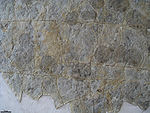
Yorgia
Encyclopedia
Yorgia waggoneri is a member of the Ediacara biota
, and resembles a cross between the organisms Dickinsonia
and Spriggina
. It has a low, segmented body consisting of a short wide "head", no appendages, and a long body region, reaching a maximum length of 25 cm (9.8 in). It is classified into an extinct animal phylum, the Proarticulata
.
) are organized in an alternating pattern relatively to the axis of the body – they are not direct mirror images. This phenomenon is described as the symmetry of gliding reflection, which is a characteristic also found in the similar Spriggina
. Some proarticulates (Yorgia, Archaeaspinus) demonstrate obvious asymmetry of left and right parts of the body. Yorgia’s initial right isomer is the only one which spreads far towards the left side of the body.
This lack of true bilateral symmetry, along with other considerations, has led some scientists to suspect that the organism falls in a sister group to the eumetazoa (i.e. all animals except the sponges and a few other oddballs).
) White sea
region of Russia
, dated around 555.5 Ma. and Yorgia sp. has been found in the Central Urals
of Russia and Flinders Ranges
, Australia
.
Most body imprints of Yorgia have in the past been primarily preserved on the sole of sandstone beds in negative relief.
Other Yorgia fossils show internal structure in the original organism, showing two symmetrical rows of nodules, a central tube, rib like tubes, and a semicircular shape with a hole in the circle centre positioned towards the head end. This structure has been interpreted as the impression of gonads, intestine and mouth.
 Some fossils appear as chains of positive imprints (the ichnospecies Epibaion
Some fossils appear as chains of positive imprints (the ichnospecies Epibaion
waggoneris), terminated by the negative imprint of the animal. Such positive imprints are confined to the "elephant skin" surface texture that is interpreted as the remains of a microbial film. They have been interpreted as the feeding tracks produced as Yorgia fed on the surface of the microbial mat
that lined the sea floor. Grazing of that bacterial film could have been accomplished by the work of numerous hair-like organs, cilia, located on the ventral side of the body, which caught and transported particles of the food substrate into the special elongated pockets arranged on the borders between the isomers
. Chevron-like marks on the positive imprints has been taken as evidence of this cilia activity.
This feeding habit is unknown in post-Ediacaran deposits.
Taphonomic details revealed in Yorgia allow interpretation of the chains of positive imprints of other proarticulates as grazing traces, as opposed to trails created as organisms were swept along the sea floor by currents. In addition to Yorgia, two fossil taxa, Epibaion and Phyllozoon, seem to have produced similar grazing traces. Small groups of positive body imprints are documented for Dickinsonia
costata as well and Dickinsonia cf. tenuis.
Ediacara biota
The Ediacara biota consisted of enigmatic tubular and frond-shaped, mostly sessile organisms which lived during the Ediacaran Period . Trace fossils of these organisms have been found worldwide, and represent the earliest known complex multicellular organisms.Simple multicellular organisms such as...
, and resembles a cross between the organisms Dickinsonia
Dickinsonia
Dickinsonia is an iconic fossil of the Ediacaran biota. It resembles a bilaterally symmetrical ribbed oval. Its affinities are presently unknown; most interpretations consider it to be an animal, although others suggest it may be fungal, or a member of an "extinct kingdom".-Species variety:A...
and Spriggina
Spriggina
Fossils of Spriggina are known from the Ediacaran period, around . The segmented organism reached about 3 cm in length and may have been predatory...
. It has a low, segmented body consisting of a short wide "head", no appendages, and a long body region, reaching a maximum length of 25 cm (9.8 in). It is classified into an extinct animal phylum, the Proarticulata
Proarticulata
Proarticulata is a proposed extinct phylum of very early bilateral animals known from fossils found in the Ediacaran fauna. Mikhail A. Fedonkin describes animals in Proarticulata as having a "shield-like" shape, an unmineralized, thin, flexible carapace and a thick, segmented body...
.
Morphology
The body plan of the Yorgia and other proarticulates is unusual for solitary (non-colonial) metazoans. These bilateral organisms have a segmented metameric body, but left and right transverse elements (isomersIsomer (Proarticulata)
Isomer is an element of transverse body articulation of the bilateral fossil animals of the Phylum Proarticulata from the Ediacaran period. This term has been proposed by Andrey Yu...
) are organized in an alternating pattern relatively to the axis of the body – they are not direct mirror images. This phenomenon is described as the symmetry of gliding reflection, which is a characteristic also found in the similar Spriggina
Spriggina
Fossils of Spriggina are known from the Ediacaran period, around . The segmented organism reached about 3 cm in length and may have been predatory...
. Some proarticulates (Yorgia, Archaeaspinus) demonstrate obvious asymmetry of left and right parts of the body. Yorgia’s initial right isomer is the only one which spreads far towards the left side of the body.
This lack of true bilateral symmetry, along with other considerations, has led some scientists to suspect that the organism falls in a sister group to the eumetazoa (i.e. all animals except the sponges and a few other oddballs).
Fossil record
Imprints of the Yorgia waggoneri has been found in the rocks of Vendian period (EdiacaranEdiacaran
The Ediacaran Period , named after the Ediacara Hills of South Australia, is the last geological period of the Neoproterozoic Era and of the Proterozoic Eon, immediately preceding the Cambrian Period, the first period of the Paleozoic Era and of the Phanerozoic Eon...
) White sea
White Sea
The White Sea is a southern inlet of the Barents Sea located on the northwest coast of Russia. It is surrounded by Karelia to the west, the Kola Peninsula to the north, and the Kanin Peninsula to the northeast. The whole of the White Sea is under Russian sovereignty and considered to be part of...
region of Russia
Russia
Russia or , officially known as both Russia and the Russian Federation , is a country in northern Eurasia. It is a federal semi-presidential republic, comprising 83 federal subjects...
, dated around 555.5 Ma. and Yorgia sp. has been found in the Central Urals
of Russia and Flinders Ranges
Flinders Ranges
Flinders Ranges is the largest mountain range in South Australia, which starts approximately north west of Adelaide. The discontinuous ranges stretch for over from Port Pirie to Lake Callabonna...
, Australia
Australia
Australia , officially the Commonwealth of Australia, is a country in the Southern Hemisphere comprising the mainland of the Australian continent, the island of Tasmania, and numerous smaller islands in the Indian and Pacific Oceans. It is the world's sixth-largest country by total area...
.
Most body imprints of Yorgia have in the past been primarily preserved on the sole of sandstone beds in negative relief.
Other Yorgia fossils show internal structure in the original organism, showing two symmetrical rows of nodules, a central tube, rib like tubes, and a semicircular shape with a hole in the circle centre positioned towards the head end. This structure has been interpreted as the impression of gonads, intestine and mouth.
Trace fossils

Epibaion
Epibaion is an Ediacaran Proarticulatan imprint, often occurring in chains, that is interpreted as a feeding trace; some chains terminate in a body fossil, allowing their maker to be identified. Several specimens are known; E. waggoneris was produced by Yorgia waggoneri; E. costatus by Dickinsonia...
waggoneris), terminated by the negative imprint of the animal. Such positive imprints are confined to the "elephant skin" surface texture that is interpreted as the remains of a microbial film. They have been interpreted as the feeding tracks produced as Yorgia fed on the surface of the microbial mat
Microbial mat
A microbial mat is a multi-layered sheet of micro-organisms, mainly bacteria and archaea. Microbial mats grow at interfaces between different types of material, mostly on submerged or moist surfaces but a few survive in deserts. They colonize environments ranging in temperature from –40°C to +120°C...
that lined the sea floor. Grazing of that bacterial film could have been accomplished by the work of numerous hair-like organs, cilia, located on the ventral side of the body, which caught and transported particles of the food substrate into the special elongated pockets arranged on the borders between the isomers
Isomer (Proarticulata)
Isomer is an element of transverse body articulation of the bilateral fossil animals of the Phylum Proarticulata from the Ediacaran period. This term has been proposed by Andrey Yu...
. Chevron-like marks on the positive imprints has been taken as evidence of this cilia activity.
This feeding habit is unknown in post-Ediacaran deposits.
Taphonomic details revealed in Yorgia allow interpretation of the chains of positive imprints of other proarticulates as grazing traces, as opposed to trails created as organisms were swept along the sea floor by currents. In addition to Yorgia, two fossil taxa, Epibaion and Phyllozoon, seem to have produced similar grazing traces. Small groups of positive body imprints are documented for Dickinsonia
Dickinsonia
Dickinsonia is an iconic fossil of the Ediacaran biota. It resembles a bilaterally symmetrical ribbed oval. Its affinities are presently unknown; most interpretations consider it to be an animal, although others suggest it may be fungal, or a member of an "extinct kingdom".-Species variety:A...
costata as well and Dickinsonia cf. tenuis.

